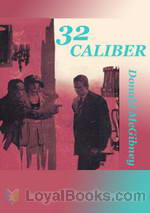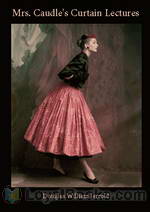|
Books Should Be Free Loyal Books Free Public Domain Audiobooks & eBook Downloads |
|
|
Books Should Be Free Loyal Books Free Public Domain Audiobooks & eBook Downloads |
|
Fiction |
|---|
|
Book type:
Sort by:
View by:
|
By: Denis Diderot (1713-1784) | |
|---|---|
 Rameau's Nephew
Rameau's Nephew
Rameau's Nephew, or the Second Satire (French: Le Neveu de Rameau ou La Satire seconde) is an imaginary philosophical conversation written by Denis Diderot, probably between 1761 and 1772. It was first published in 1805 in German translation by Goethe, but the French manuscript used has subsequently disappeared. The German version was translated back into French by de Saur and Saint-Genies and published in 1821. The first published version based on French manuscript appeared in 1823 in the Brière edition of Diderot's works... | |
By: Dillon Wallace (1863-1939) | |
|---|---|
 The Gaunt Gray Wolf A Tale of Adventure With Ungava Bob
The Gaunt Gray Wolf A Tale of Adventure With Ungava Bob
| |
 Ungava Bob A Winter's Tale
Ungava Bob A Winter's Tale
| |
 Left on the Labrador A Tale of Adventure Down North
Left on the Labrador A Tale of Adventure Down North
| |
By: Dinah Craik (1826-1887) | |
|---|---|
 John Halifax, Gentleman
John Halifax, Gentleman
This novel, published in 1856, was one of the popular and beloved novels in the Victorian era. It is told in the first person by Phineas Fletcher, an invalid son of a Quaker tanner who is presented to us in the beginning as a lonely youth. John Halifax, the first friend he ever had, is a poor orphan who is taken in by his father to help in the work which his sickly son can't constantly do. Phineas tells us in an unforgettable way how John succeeded in rising from his humble beginning and become a wealthy and successful man. But with the money come horrible troubles... In an unforgettable manner, we learn to know all the characters of the novel as if they really lived. | |
By: Dinah Maria Craik (1826-1887) | |
|---|---|
 Olive
Olive
Inspired by Jane Eyre, Dinah Maria Craik's 1850 novel, Olive, was one of the first to feature a disabled central character. 'Slightly deformed' from birth, Olive believes that she will never be able to marry like other women, so she devotes her life to her art, her mother, and above all, her religion. It takes a dark secret from the past and a new, fascinating acquaintance, to make her realize what her life could be. | |
By: Dinah Maria Mulock Craik (1826-1887) | |
|---|---|
 Fairy Book
Fairy Book
The sleeping beauty in the wood -- Hop-O'-My-Thumb -- Cinderella; or, the little glass slipper -- Adventures of John Dietrich -- Beauty and the Beast -- Little One Eye, Little Two Eyes, and Little Three Eyes -- Jack the giant-killer -- Tom Thumb -- Rumpelstilzchen -- Fortunatus -- The Bremen Town Musicians -- Riquet with the tuft -- House Island -- Snow-White and Rose-Red -- Jack and the bean-stalk -- Graciosa and Percinet -- The iron stove -- The invisible prince -- The woodcutter's daughter --... | |
 The Adventures of A Brownie As Told to My Child by Miss Mulock
The Adventures of A Brownie As Told to My Child by Miss Mulock
| |
 Agatha's Husband A Novel
Agatha's Husband A Novel
| |
By: Dion Clayton Calthrop (1878-1937) | |
|---|---|
 The Pirate's Pocket Book
The Pirate's Pocket Book
| |
By: Dolf Wyllarde | |
|---|---|
 The Pathway of the Pioneer
The Pathway of the Pioneer
The story of seven girls who have banded themselves together for mutual help and cheer under the name of “Nous Autres.” They represent, collectively, the professions open to women of no deliberate training, though well educated. They are introduced to the reader at one of their weekly gatherings and then the author proceeds to depict the home and business life of each one individually. (From the 1909 back-of-book advertisement) | |
By: Dom Bede Camm (1864-1942) | |
|---|---|
 Voyage of the Pax
Voyage of the Pax
An amazing allegorical story about the journey to Heaven, using the image of a journey across the water in a ship named The Pax. St. Benedict's Rule helps to keep the travelers faithful to their goal. They encounter storms, monsters, and enticing islands along the way... if you were in the ship, would you stay the course through all the temptations? | |
By: Don Marquis (1878-1937) | |
|---|---|
 The Cruise of the Jasper B.
The Cruise of the Jasper B.
| |
 Hermione's Group of Thinkers
Hermione's Group of Thinkers
| |
By: Don Peterson | |
|---|---|
 The White Feather Hex
The White Feather Hex
| |
By: Donald Alexander Mackenzie (1873-1936) | |
|---|---|
 Elves and Heroes
Elves and Heroes
This volume describes, in verse, the mythical creatures and people of ancient Scotland. It also includes explanatory notes about about the characters and folk tales that inspired the author's poetry. (Introduction by Matthew Reece) | |
By: Donald McGibney | |
|---|---|
 32 Caliber
32 Caliber
The recent interest that's being generated in the pulp fiction writers of the 1920s has lead to many of the books of that genre being resurrected and read once again. For modern-day readers, these represent what are now called “airport-lounge reads” and ideal for those few hours that you have to kill waiting in an airport or railway station, while traveling or on holiday, when you don't want anything too heavy to weigh you down! Pulp fiction, so called because the books were generally printed on cheaper paper made from recycled wood pulp, had certain characteristics... | |
By: Donald Wollheim (1914-1990) | |
|---|---|
 The Secret Of The Ninth Planet
The Secret Of The Ninth Planet
An alien race has put a station on Earth and other planets in order to steal the rays of the sun, possible causing the sun to nova within two years. Burl Denning, a high school student, is the only person who has the power to stop the alien project. Can he and the crew of the experimental space ship Magellan act in time to save the earth? | |
By: Donn Byrne (1889-1928) | |
|---|---|
 Messer Marco Polo
Messer Marco Polo
| |
 The Wind Bloweth
The Wind Bloweth
| |
By: Dornford Yates (1885-1960) | |
|---|---|
 Berry and Co.
Berry and Co.
| |
 The Brother of Daphne
The Brother of Daphne
| |
 Jonah and Co.
Jonah and Co.
| |
By: Dorothy C. Paine | |
|---|---|
 A Little Florida Lady
A Little Florida Lady
This is the story of a little girl from New York who moves with her family to Florida in the late 19th Century. Parental warning: as this book was first published in 1903 and set in the American South, and although the author tries to be open-minded, please be aware that there are slang words used for African Americans. | |
By: Dorothy Canfield Fisher (1879-1958) | |
|---|---|
 The Bent Twig
The Bent Twig
Semi-autobiographical series of incidents in the life of an intellectual American family in the late 19th - early 20th Century as seen by favored daughter, Sylvia Marshall. Her father is an economics professor in a Midwestern state university and she is following in his inquisitive footsteps. Canfield writes this in a matter-of-fact manner with Tarkingtonesque good humor. | |
 The Squirrel-Cage
The Squirrel-Cage
| |
By: Dorothy Kilner (1755-1836) | |
|---|---|
 Life and Perambulations of a Mouse
Life and Perambulations of a Mouse
| |
By: Dorothy L. Sayers (1893-1957) | |
|---|---|
 Whose Body?
Whose Body?
The first novel in her renowned series of detective fiction, Sayers introduces Lord Peter Wimsey, a bon vivant gentleman, whose hobby of playing detective is put to the test, as he is launched into his first official crime investigation. The mystery begins when the body of an unidentified man has been found in the bathtub of local architect Mr. Thipps. Adding to the peculiarity of the situation is the fact that the corpse is stark naked except for a pair of expensive pince-nez glasses. Due to the incriminating circumstances of the murder, the official investigator suspects Thipps to be the perpetrator of the bizarre murder... | |
By: Dorothy Richardson (1873-1957) | |
|---|---|
 Pointed Roofs
Pointed Roofs
Miriam Henderson is one of what novelist Dolf Wyllarde (in her great work, The Pathway of the Pioneer) termed "nous autres," i.e., young gentlewomen who must venture forth and earn their living after their fathers have been financially ruined. Also, she has read Villette; she thus applies for and is offered a job teaching conversational English at a girls' school, albeit in Germany rather than France. Pointed Roofs describes her year abroad, as she endeavors to make her way in the hotbed of seething female personalities that populate the school, overseen by her employer, the formidable Fraulein... | |
 Backwater (Pilgrimage, Vol. 2)
Backwater (Pilgrimage, Vol. 2)
"Backwater" is the second volume of "Pilgrimage," a series of thirteen autobiographical novels by Dorothy Richardson considered to have pioneered the "stream of consciousness" technique of writing. In a review of the first volume in the series, "Pointed Roofs" (The Egoist April 1918), May Sinclair first applied the term "stream of consciousness" in her discussion of Richardson's stylistic innovations. Richardson, however, preferred the term "interior monologue." Miriam Henderson, the central character in Pilgrimage, is based on the author's own life between 1891 and 1915... | |
By: Dorothy Wayne (0-0) | |
|---|---|
 Dorothy Dixon and the Mystery Plane
Dorothy Dixon and the Mystery Plane
Young peoples book of adventure in aviation with young women in the lead rolls. This is in the earlier days of aviation. | |
By: Dorothy Whitehill | |
|---|---|
 Phyllis A Twin
Phyllis A Twin
| |
By: Douglas Fairbanks (1883-1939) | |
|---|---|
 Laugh and Live
Laugh and Live
Douglas Fairbanks, Sr. (May 23, 1883 – December 12, 1939) was an American actor, screenwriter, director and producer. He was best known for his swashbuckling roles in silent films such as The Thief of Baghdad, Robin Hood, and The Mark of Zorro. His book, Laugh and Live, is a book about positive virtues and advice for leading a good, healthy, and successful life. An advisory about this book is in order. Published in 1917, it was written at a time when “men went to work, women kept house, and supported their man”... | |
By: Douglas Grant (aka Isabel Ostrander) (1883-1924) | |
|---|---|
 Anything once
Anything once
An unlikely pair of wanderers they were; the orphan girl Lou and her travelling partner Jim Botts. Jim appeared in need of following some apparent 'rules' during the journey, while Lou seemed in need of better clothing, and perhaps some refinement. But who was most benefitting whom on the week-long journey from rural village to big city? And which of the two was willing to try anything once? (Introduction by Roger Melin) | |
By: Douglas William Jerrold (1803-1857) | |
|---|---|
 Mrs. Caudle's Curtain Lectures
Mrs. Caudle's Curtain Lectures
First serialized in Punch magazine in 1845, and officially published in book form in 1846, Mrs. Caudle's Curtain Lectures presents a collection of 37 lectures delivered by Mrs. Caudle to her husband as a means of reproach for his trivial infractions. Also, the author marvelously incorporates typical elements responsible for disagreements between spouses including the antipathetic mother-in-law, the ne’er-do-well friends, and the jealous outbursts. Jerrold’s charming piece of satire introduces the Victorian married couple, Mr... | |
By: Dreiser, Theodore (1871-1945) | |
|---|---|
 Hollywood: Its Morals and Manners
Hollywood: Its Morals and Manners
Serialized in Shadowland from November 1921 to February 1922, Hollywood: Its Morals and Manners is Theodore Dreiser's shocking four part expose on the motion picture industry. In it, he shares his observations from his extended stay in Los Angeles, and gives us an intimate look at the seedier underside of Hollywood. | |
By: E. (Eliza) Fenwick (1766-1840) | |
|---|---|
 The Bad Family & Other Stories
The Bad Family & Other Stories
| |
By: E. (Emanuel) Haldeman-Julius (1888-1951) | |
|---|---|
 Dust
Dust
| |
By: E. A. Gillie | |
|---|---|
 Barbara in Brittany
Barbara in Brittany
Barbara, an English girl and the eldest of her family, spends most days helping her widowed mother care for her younger siblings. Then disaster strikes – or so the children believe! Barbara is taken to France to see Paris by her father’s formidable sister, Aunt Anne. She stays on in Brittany to perfect her French. In this series of funny stories about her adventures in France, we meet a cast of recurring characters – and both Barbara and Aunt Anne find love! (Summary by Sibella Denton) | |
By: E. C. (Edmund Clerihew) Bentley (1875-1956) | |
|---|---|
 Trent's Last Case
Trent's Last Case
| |
By: E. Cherubini | |
|---|---|
 Pinocchio in Africa
Pinocchio in Africa
| |
By: E. E. Boyd | |
|---|---|
 'Our Guy' or, The elder brother
'Our Guy' or, The elder brother
| |
By: E. E. Smith (1895-1965) | |
|---|---|
 Spacehounds of IPC
Spacehounds of IPC
When the Inter-Planetary Corporation's (IPC) crack liner “IPV Arcturus” took off on a routine flight to Mars, it turned out to be the beginning of a unexpected and long voyage. There had been too many reports of errors in ship's flight positions from the Check Stations and brilliant physicist Dr. Percival (“Steve”) Stevens is aboard the Arcturus on a fact-finding mission to find out what's really happening, and hopefully save the honor of the brave pilots of the space-liner Arcturus from the desk-jockeys' in the Check Stations implications of imprecision - the nastiest insult you could cast at a ships pilot... | |
 Skylark Three
Skylark Three
This is a sequel to The Skylark of Space. The novel concerns Richard Seaton and his allies who have encounters with aliens while fighting DuQuesne and the Fenachrone.. | |
 Subspace Survivors
Subspace Survivors
A team of space travelers are caught in a subspace accident which, up to now, no one has ever survived. But some of the survivors of the Procyon are not ordinary travelers. Their psi abilities allow them to see things before they happen. But will it be enough?Smith's story "Subspace Survivors" first appeared in the July 1960 issue of the magazine Astounding. | |
 Galaxy Primes
Galaxy Primes
They were four of the greatest minds in the Universe: Two men, two women, lost in an experimental spaceship billions of parsecs from home. And as they mentally charted the Cosmos to find their way back to earth, their own loves and hates were as startling as the worlds they encountered. | |
 First Lensman
First Lensman
The Secret Planet. No human had ever landed on the hidden planet of Arisia. A mysterious space barrier turned back both men and ships. Then the word came to Earth, "Go to Arisia!", Virgil Samms of the Galactic Patrol went--and came back with the Lens, the strange device that gave its wearer powers no man had ever possessed before. Samms knew the price of that power would be high. But even he had no idea of the ultimate cost, and the weird destiny waiting for the First Lensman. First Lensman is the sequel to Triplanetary, and the second book of E.E. "Doc" Smith's classic Lensman series. (from the original book cover and Mark Nelson) | |
 Lord Tedric
Lord Tedric
Time is the strangest of all mysteries. Relatively unimportant events, almost unnoticed as they occur, may, in hundreds of years, result in Ultimate Catastrophe. On Time Track Number One, that was the immutable result. But on Time Track Number Two there was one little event that could be used to avert it—the presence of a naked woman in public. So, Skandos One removed the clothing from the Lady Rhoann and after one look, Lord Tedric did the rest! | |
 Lord Tedric (version 2)
Lord Tedric (version 2)
The best of science fantasy meets the best of science fiction as Tedric battles his way through two universes of adventure: In one universe...Tedric the Ironmaster wields the mightiest sword his world has ever seen - and swears to break the power of the evil god Sarpedion, or die in the attempt. This is the second in a series and takes place when Tedric, now a Lord, begins learning how to plan and observe instead of just rushing in to kill. In another universe...only Tedric's strength and daring stand between the dwindling power of the Terran Empire and total alien conquest... | |
 Tedric
Tedric
This is a wonderful combination of far future science fiction with Conan like sword and sorcery; lots of blood, gore, honor and evil. The immensely powerful hero, Tedric, is a man's man who refuses to accept the cruel human sacrifices demanded by the 'god' Sarpedion and is set on destroying him. To do this he needs some secrets of metallurgy that future social scientists are willing to give him. He manages to overcome all obstacles until of course he meets the dazzlingly lovely Lady Rhoaan who stops him cold... | |
By: E. E. “Doc” Smith (1890-1965) | |
|---|---|
 Triplanetary, First in the Lensman Series
Triplanetary, First in the Lensman Series
Triplanetary was first serialized in Amazing Stories in 1934. After the Lensman series became popular, Smith took his Triplanetary story and turned it into the first of the Lensman series, using it as a prequel to give the back story for the protaganists in the Lensmen series. He added 6 new chapters, doubling it in size and it's really a different book from the serialized novel, being published 14 years after the first. It was put into Gutenberg just last year. The novel covers several episodes in an eons-long eugenics project of the super-intelligences of the Arisia... | |
By: E. F. Benson (1867-1940) | |
|---|---|
 Dodo's Daughter
Dodo's Daughter
The second in the "Dodo" sequence of novels. | |
 Room in the Tower, and Other Stories
Room in the Tower, and Other Stories
These stories have been written in the hopes of giving some pleasant qualms to their reader, if by chance, anyone be occupying in their perusal a leisure half-hour before he goes to bed when the night and the house are still, he may perchance cast an occasional glance into the corners and dark places of the room where he sits, to make sure that nothing unusual lurks in the shadow. For this is the avowed object of ghost stories and such tales as deal with the dim unseen forces which occasionally and perturbingly make themselves manifest. The author therefore fervently wishes his readers a few uncomfortable moments. Preface - by E.F. Benson | |
By: E. Frances (Eleanor Frances) Poynter | |
|---|---|
 My Little Lady
My Little Lady
| |
By: E. Gallienne Robin | |
|---|---|
 Where Deep Seas Moan
Where Deep Seas Moan
| |
By: E. H. (Emily Hilda) Young (1880-1949) | |
|---|---|
 Moor Fires
Moor Fires
| |